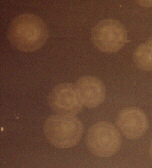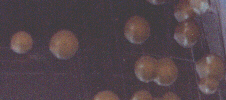
 |

![]()
![]() Morphology and physiology
Morphology and physiology
![]()
![]() The morphology and
physiology researches showed that luminescent bacteria are very
similar to enteric bacteria.
The morphology and
physiology researches showed that luminescent bacteria are very
similar to enteric bacteria.
![]()
![]() It is possible to
observe the shape of luminescent bacteria cells using popular
light microscope. The bacterial cells are more visible when
special method of staining is used. There are many methods of
staining. I used the Gram staining method and the negative
staining method. Click on the link below to see some photos of
luminescent bacteria cells.
It is possible to
observe the shape of luminescent bacteria cells using popular
light microscope. The bacterial cells are more visible when
special method of staining is used. There are many methods of
staining. I used the Gram staining method and the negative
staining method. Click on the link below to see some photos of
luminescent bacteria cells.
| SOME PHOTOS OF LUMINESCENT BACTERIA CELLS |
![]()
![]() Every luminescent
bacteria are Gram-negative. Bacterial cells have motion organs -
flagella (they are visible in light microscope only when special
method of staining is used). In the case of Vibrio
genus polar flagella are enclosed in a sheath continuous with the
outer membrane of the cell wall. In the case of Photobacterium
genus only unsheathed flagella are present.
Every luminescent
bacteria are Gram-negative. Bacterial cells have motion organs -
flagella (they are visible in light microscope only when special
method of staining is used). In the case of Vibrio
genus polar flagella are enclosed in a sheath continuous with the
outer membrane of the cell wall. In the case of Photobacterium
genus only unsheathed flagella are present.
![]()
![]() On the basis of my
photos
and other data (electron micrographs, phase contrast micrographs)
we can create the simplified pictures of luminous bacteria.
On the basis of my
photos
and other data (electron micrographs, phase contrast micrographs)
we can create the simplified pictures of luminous bacteria.
|
a - bacterial cell b - unsheathed flagella |
a - bacterial cell b - sheathed flagella |
|

![]() On
the constant media luminous bacteria (like other bacteria) can
form the colonies. Colonies are visible aggregations of bacterial
cells (about 2-8 mm in diameter). Colony can be created by one
bacterial cell in the way of multiple cell divisions. On the
photo on the left colonies of the luminescent bacterium Photobacterium
luciferum are shown.
On
the constant media luminous bacteria (like other bacteria) can
form the colonies. Colonies are visible aggregations of bacterial
cells (about 2-8 mm in diameter). Colony can be created by one
bacterial cell in the way of multiple cell divisions. On the
photo on the left colonies of the luminescent bacterium Photobacterium
luciferum are shown.  The
photo on the right shows the colonies of the luminescent
bacterium Vibrio fischeri.
The
photo on the right shows the colonies of the luminescent
bacterium Vibrio fischeri.
![]()
![]() The luminescence
ability is in strict dependence on the medium composition. The
light generating reactions require oxygen. The luminescence
process is something like the offshoot of the aerobic respiration.
The main difference is that the final product of aerobic
respiration is ATP and the final product of luminescence
reactions is excited luciferase (chemical compound) which can
generate light.
The luminescence
ability is in strict dependence on the medium composition. The
light generating reactions require oxygen. The luminescence
process is something like the offshoot of the aerobic respiration.
The main difference is that the final product of aerobic
respiration is ATP and the final product of luminescence
reactions is excited luciferase (chemical compound) which can
generate light.
| SCHEME OF THE LUMINESCENCE REACTIONS |
![]()
![]() Interesting is the
fact, that luminescent bacteria do not produce light (or produce
it very weakly) when their cells are in considerable dispersion (e.g.
in the sea-water). In contrast, when many cells are in condensed
suspensions (e.g. cultures growing in the liquid, microbiological
mediums) they produce light very efficiently.
Interesting is the
fact, that luminescent bacteria do not produce light (or produce
it very weakly) when their cells are in considerable dispersion (e.g.
in the sea-water). In contrast, when many cells are in condensed
suspensions (e.g. cultures growing in the liquid, microbiological
mediums) they produce light very efficiently.
![]()
![]() The researches
show that luminescent bacteria produce specific chemical compound
- autoinducer which can induce bioluminescence reactions in
bacterial cells if present in environment in actual concentration.
The researches
show that luminescent bacteria produce specific chemical compound
- autoinducer which can induce bioluminescence reactions in
bacterial cells if present in environment in actual concentration.
When many bacterial cells are present in the environment, the
concentration of autoinducer grows and luminescence is induced
very efficiently.
![]()
![]() Similarly,
luminescent bacteria cells which live in sea-water do not produce
light but the cells which live in luminous organs of marine
animals produce it very effectively. It is possible because the
quantity of bacterial cells in these organs reach 1010 cells/ml.
Similarly,
luminescent bacteria cells which live in sea-water do not produce
light but the cells which live in luminous organs of marine
animals produce it very effectively. It is possible because the
quantity of bacterial cells in these organs reach 1010 cells/ml.
![]()
![]() Other chemical
compounds similar to autoinducer were isolated from other
bacteria species which do not produce light. Perhaps in this case
their role is informational. On the base of concentration of
these compounds bacterial cell "knows" how many other
cells are in close nearness.
Other chemical
compounds similar to autoinducer were isolated from other
bacteria species which do not produce light. Perhaps in this case
their role is informational. On the base of concentration of
these compounds bacterial cell "knows" how many other
cells are in close nearness.
1.
|
2.
|
![]() The
photos above show colonies of luminescent bacterium - Vibrio
fischeri on the medium "BOSS". This bacterium is
most intensively light-producing bacteria in my collection. Photo
1 was taken in the normal light terms and photo 2 was taken in
the dark. I was applying the long-time exposure (40 sec.).
The
photos above show colonies of luminescent bacterium - Vibrio
fischeri on the medium "BOSS". This bacterium is
most intensively light-producing bacteria in my collection. Photo
1 was taken in the normal light terms and photo 2 was taken in
the dark. I was applying the long-time exposure (40 sec.).
![]() (click on the photo to see it
better)
(click on the photo to see it
better)
 RETURN TO THE TOP |
HOME PAGE | NATURAL ENVIRONMENT | MORPHOLOGY AND PHYSIOLOGY |
| These pages were created by Piotr Madanecki |
| e-mail: pmad@eniac.farmacja.amg.gda.pl |